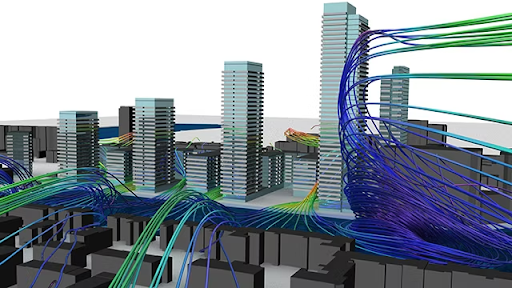TotalSim Uses Architectural Systems Capabilities To Improve Smell Surrounding Major Hospital
The Situation:
A major hospital in Columbus, OH was receiving complaints from occupants about a bad smell that was occasionally permeating certain floors and rooms. The smell was interrupting the daily life of the occupants and reflecting poorly on the medical facility.
Client Challenge:
The particular building where the smell was originating from was set to be revamped in the near future. The corporation was planning to install a large fan to try to blow the smell away from the HVAC intakes and needed to know what the best placement for the fan was to facilitate this and whether this investment would address the problem.
Type of TotalSim Engagement:
TotalSim was called in to use our architectural system capabilities to identify the source of the smell and find possible solutions that could be made in the near future.

What TotalSim did:
TotalSim was able to obtain geometry files of the external geometry of the hospital, including the HVAC intake and exhaust locations and several blocks of the surrounding buildings. We used these to simulate the path of HVAC air coming in and out of the building for summer, winter and fall conditions. We then blew the wind at the building from various directions at various speeds and were able to evaluate where the HVAC intake air was coming from for each of the floors and for each of the different scenarios.
Through this process we were able to find the source of the smell and the pathway it took entering the hospital.
Results:
Having identified the source of the smell, we were able to confirm the best placement for the fan and determine whether the proposed renovation to the building layouts would make for optimal unpleasent odor reduction.
Our simulations saved the establishment money that would’ve otherwise been spent on creating physical testing scenarios and prevented the possibility of the company constructing a new building layout that would still have the same issue or worse, exacerbate it.
Similar Projects:
Learn more about the ways TotalSim can help you overcome your aerodynamic challenges
*What is CFD?
Computational fluid dynamics (CFD) is a branch of fluid mechanics that uses computer numerical analysis and data structures to analyze and solve problems that involve fluid flows, typically solved on large supercomputers. Fluid mechanics plays a significant role in the engineering process when developing new designs. Analyzing the aerodynamic and thermal qualities of a product using experimentation is a well-established approach however experimentation can be costly, limiting, time-consuming, and difficult to execute especially on a large scale. Progression of computing power has allowed the field of CFD to prosper acting as a complement to physical testing and in some cases replacing it. CFD is the science of predicting fluid flow, heat transfer, mass transfer, chemical reactions, and other flow properties by solving governing fluid flow equations using numerical methods. Across the industry, CFD is routinely used to drive product development, troubleshoot issues, study and optimize new designs and concepts, and map performance. CFD methods are heavily used across many disciplines with motorsports being a leading proponent.
